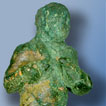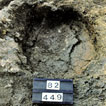Roman Spirituality
Religion was a hugely important part of the way in which ancient people saw their world. This is one of the aspects of ancient life that modern people find hardest to grasp, because our world-view is so different. For the Silures, many features of their lives and the landscape that surrounded them must have had religious significance, but it is not likely that we will ever be able to discover more than a tiny fraction of them.
Celtic religious places were focussed on natural features such as water, like the famous lake at Llyn Fawr, Rhigos, where a large collection of metalwork was deposited as an offering at the time when the Bronze Age was giving way to the Iron Age. Sites like this are unlikely to leave any traces on the landscape, particularly if the sacred pool has filled up - they are normally only found by accident. We think that some of the finds of Iron Age and Roman objects made by metal detectorists at various watery places in the Vale of Glamorgan and Monmouthshire may have been offerings deposited to the gods there.
Under Roman influence, the British started to build stone temples. Very few of these are known in our area, although one has been excavated and put on display at Caerwent, and a temple to Diana is known from an inscription at Caerleon. What seems to be a rural sanctuary has been found from the air at Gwehelog just outside Usk although it has not been excavated. In the home, people would have had small altars to make offerings to the gods of the household, whose statues would have stood in a little shrine close by. Fragments of little statues to popular gods, in bronze and pipeclay, are sometimes found during excavation. In the 3rd and 4th century there is a little evidence for Christianity, including the story of the martyrdom of St Julian and St Aaron at Caerleon.
According to Roman law and custom, the dead were buried away from places where people lived. A common place for cemeteries was alongside the roads leading into a settlement. In the 1st and 2nd centuries most people were cremated, often with selected belongings and food and drink. The ashes were buried in pots, caskets or bags. In the 3rd and 4th centuries the fashion changed to burial in a coffin of wood, stone or lead. Because the soil over most of our area is acidic, the skeletons in these later burials have often dissolved away completely.



